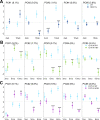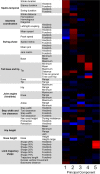Rapid and robust patterns of spontaneous locomotor deficits in mouse models of Huntington's disease
- PMID: 33370315
- PMCID: PMC7769440
- DOI: 10.1371/journal.pone.0243052
Rapid and robust patterns of spontaneous locomotor deficits in mouse models of Huntington's disease
Abstract
Huntington's disease (HD) is an inherited neurodegenerative disorder characterized by severe disruption of cognitive and motor functions, including changes in posture and gait. A number of HD mouse models have been engineered that display behavioral and neuropathological features of the disease, but gait alterations in these models are poorly characterized. Sensitive high-throughput tests of fine motor function and gait in mice might be informative in evaluating disease-modifying interventions. Here, we describe a hypothesis-free workflow that determines progressively changing locomotor patterns across 79 parameters in the R6/2 and Q175 mouse models of HD. R6/2 mice (120 CAG repeats) showed motor disturbances as early as at 4 weeks of age. Similar disturbances were observed in homozygous and heterozygous Q175 KI mice at 3 and 6 months of age, respectively. Interestingly, only the R6/2 mice developed forelimb ataxia. The principal components of the behavioral phenotypes produced two phenotypic scores of progressive postural instability based on kinematic parameters and trajectory waveform data, which were shared by both HD models. This approach adds to the available HD mouse model research toolbox and has a potential to facilitate the development of therapeutics for HD and other debilitating movement disorders with high unmet medical need.
Conflict of interest statement
CHDI Foundation is a nonprofit biomedical research organization exclusively dedicated to collaboratively developing therapeutics that substantially improve the lives of those affected by Huntington’s disease. CHDI Foundation conducts research in a number of different ways; for the purposes of this manuscript, all research was conceptualized, planned, and directed by all authors and conducted at the contract research organization Charles River Discovery Services Finland. This does not alter our adherence to PLOS ONE policies on sharing data and materials.
Figures




Similar articles
-
Progressive gene dose-dependent disruption of the methamphetamine-sensitive circadian oscillator-driven rhythms in a knock-in mouse model of Huntington's disease.Exp Neurol. 2016 Dec;286:69-82. doi: 10.1016/j.expneurol.2016.09.007. Epub 2016 Sep 16. Exp Neurol. 2016. PMID: 27646506
-
Circadian dysfunction in the Q175 model of Huntington's disease: Network analysis.J Neurosci Res. 2019 Dec;97(12):1606-1623. doi: 10.1002/jnr.24505. Epub 2019 Jul 29. J Neurosci Res. 2019. PMID: 31359503 Free PMC article.
-
A Longitudinal Motor Characterisation of the HdhQ111 Mouse Model of Huntington's Disease.J Huntingtons Dis. 2016 May 31;5(2):149-61. doi: 10.3233/JHD-160191. J Huntingtons Dis. 2016. PMID: 27258586 Free PMC article.
-
Murine Models of Huntington's Disease for Evaluating Therapeutics.Methods Mol Biol. 2018;1780:179-207. doi: 10.1007/978-1-4939-7825-0_10. Methods Mol Biol. 2018. PMID: 29856020 Review.
-
Mouse Models of Huntington's Disease.Methods Mol Biol. 2018;1780:97-120. doi: 10.1007/978-1-4939-7825-0_6. Methods Mol Biol. 2018. PMID: 29856016 Review.
Cited by
-
Synaptic Vesicle Glycoprotein 2A Is Affected in the Central Nervous System of Mice with Huntington Disease and in the Brain of a Human with Huntington Disease Postmortem.J Nucl Med. 2022 Jun;63(6):942-947. doi: 10.2967/jnumed.121.262709. Epub 2021 Sep 16. J Nucl Med. 2022. PMID: 34531262 Free PMC article.
-
Global Rhes knockout in the Q175 Huntington's disease mouse model.PLoS One. 2021 Oct 14;16(10):e0258486. doi: 10.1371/journal.pone.0258486. eCollection 2021. PLoS One. 2021. PMID: 34648564 Free PMC article.
-
Modulation of histone H3K4 dimethylation by spermidine ameliorates motor neuron survival and neuropathology in a mouse model of ALS.J Biomed Sci. 2022 Dec 20;29(1):106. doi: 10.1186/s12929-022-00890-3. J Biomed Sci. 2022. PMID: 36536341 Free PMC article.
-
Expression of human A53T alpha-synuclein without endogenous rat alpha-synuclein fails to elicit Parkinson's disease-related phenotypes in a novel humanized rat model.PLoS One. 2025 Aug 8;20(8):e0329823. doi: 10.1371/journal.pone.0329823. eCollection 2025. PLoS One. 2025. PMID: 40779487 Free PMC article.
-
Next Generation Exon 51 Skipping Antisense Oligonucleotides for Duchenne Muscular Dystrophy.Nucleic Acid Ther. 2023 Jun;33(3):193-208. doi: 10.1089/nat.2022.0063. Epub 2023 Apr 10. Nucleic Acid Ther. 2023. PMID: 37036788 Free PMC article.
References
-
- Barclay OR. Some aspects of the mechanics of mammalian locomotion. J Exp Biol. 1953;30: 116–120.
-
- Muybridge E. The attitudes of animals in motion. Palo Alto, CA; 1881.
Publication types
MeSH terms
Substances
LinkOut - more resources
Full Text Sources
Medical
Molecular Biology Databases

